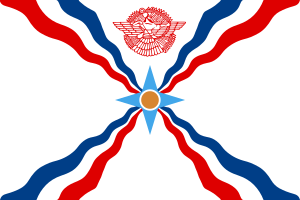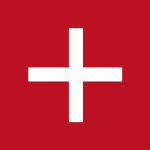Assyrian flag: Difference between revisions
article is completely unreferenced. |
WestAssyrian (talk | contribs) The Assyrian flag represents the Assyrians! how cant you accept that? |
||
| Line 1: | Line 1: | ||
{{unreferenced|date=August 2007}} |
{{unreferenced|date=August 2007}} |
||
[[Image:FlagofAssyria.svg|300px|thumb|right|The Assyrian flag.]] |
[[Image:FlagofAssyria.svg|300px|thumb|right|The Assyrian flag.]] |
||
The '''[[Assyrian people|Assyrian]] flag''' |
The '''[[Assyrian people|Assyrian]] flag''' ([[Syriac language|Assyrian]]: <big><big>ܐܬܐ ܕܐܬܘܪ</big></big>, ''Ata D'Atoor'') is the flag that universally represents the [[Assyrian people|Assyrian nation]] in the [[Assyrian homeland|homeland]] and in the [[Assyrian diaspora|diaspora]]. |
||
George Atanos first designed the flag in 1968. The [[Assyrian Universal Alliance]], Assyrian National Federation and [[Bet-Nahrain Democratic Party]] all adopted it in 1971. |
George Atanos first designed the flag in 1968. The [[Assyrian Universal Alliance]], Assyrian National Federation and [[Bet-Nahrain Democratic Party]] all adopted it in 1971. |
||
| Line 18: | Line 18: | ||
[[Image:Oldassyrianflag.jpg|150px|thumb|right|{{FIAV|historical}} Old Assyrian flag, prior to World War I]] |
[[Image:Oldassyrianflag.jpg|150px|thumb|right|{{FIAV|historical}} Old Assyrian flag, prior to World War I]] |
||
[[Image:FlagofAssyria 1913-1923.svg|150px|thumb|right|{{FIAV|historical}} The Assyrian flag during World War I]] |
[[Image:FlagofAssyria 1913-1923.svg|150px|thumb|right|{{FIAV|historical}} The Assyrian flag during World War I]] |
||
Prior to [[World War I]], the Assyrian flag consisted of 3 layers of salmon, white, and red. On the top left of the first layer, 3 white stars represented the three main Churches of the |
Prior to [[World War I]], the Assyrian flag consisted of 3 layers of salmon, white, and red. On the top left of the first layer, 3 white stars represented the three main Churches of the Syrian rite: the [[Church of the East]], [[Chaldean Catholic Church]], and [[Syriac Orthodox Church]] (it is also used by members of the [[Syriac Catholic Church]]). |
||
This flag was used during [http://www.bethsuryoyo.com/images/GalleryPics/AssyrianDelegationUN/UnDeleg1.html delegation meetings] with Assyrian politicians and Western powers during and post World War I. The flag was used until the current design was established. The flag was created by the [[Syriac Orthodox]] community of [[Tur Abdin]].{{Fact|date=September 2007}} |
This flag was used during [http://www.bethsuryoyo.com/images/GalleryPics/AssyrianDelegationUN/UnDeleg1.html delegation meetings] with Assyrian politicians and Western powers during and post World War I. The flag was used until the current design was established. The flag was created by the [[Syriac Orthodox]] community of [[Tur Abdin]].{{Fact|date=September 2007}} |
||
Between 1915 and 1923, the Assyrian army used a flag that resembled the [[flag of Switzerland]]. It consisted of a red background, indicating the blood spilled by the Assyrians prior to and during [[World War I]], and a white cross. The top left corner contained a round seal, which was [[Agha Petros]]'s personal stamp. The seal had his name on it in two languages ([[Assyrian Neo-Aramaic|Assyrian]] and [[Russian language|Russian]]). |
Between 1915 and 1923, the Assyrian army used a flag that resembled the [[flag of Switzerland]]. It consisted of a red background, indicating the blood spilled by the Assyrians prior to and during [[World War I]], and a white cross. The top left corner contained a round seal, which was [[Agha Petros]]'s personal stamp. The seal had his name on it in two languages ([[Assyrian Neo-Aramaic|Assyrian]] and [[Russian language|Russian]]). |
||
==Assyrian symbols throughout history== |
|||
==Gallery== |
|||
<gallery> |
<gallery> |
||
Image:Ashur5.jpg|The Assyrian star |
Image:Ashur5.jpg|The Assyrian star is borrowed from the ancient Babylonian symbol of [[Shamash]]. |
||
Image:Ashur god.jpg| |
Image:Ashur god.jpg|Above the blue star in red (although sometimes in gold) is a "feather-robed archer" figure symbolic of [[Ashur (god)|Ashur]]. |
||
Image:Kawkbo Othuroyo b-'Idto d-Mor Gabriel 1.jpg|Star symbol in the [[Mor Gabriel monastery]] |
Image:Kawkbo Othuroyo b-'Idto d-Mor Gabriel 1.jpg|Star symbol in the [[Mor Gabriel monastery]], which later was added on the Assyrian flag. |
||
Image:Flag of Iraq 1959-1963.svg| |
Image:Flag of Iraq 1959-1963.svg|An old [[flag of Iraq]], the red star in the centre represents the Assyrian population. |
||
</gallery> |
</gallery> |
||
==References== |
==References== |
||
Revision as of 21:22, 12 November 2008

The Assyrian flag (Assyrian: ܐܬܐ ܕܐܬܘܪ, Ata D'Atoor) is the flag that universally represents the Assyrian nation in the homeland and in the diaspora.
George Atanos first designed the flag in 1968. The Assyrian Universal Alliance, Assyrian National Federation and Bet-Nahrain Democratic Party all adopted it in 1971. The flag has a white background with a golden circle at the center, surrounded by a four-pointed star in blue. Four triple-coloured (red-white-blue), widening, wavy stripes connect the center to the four corneds of the flag. The Bet-Nahrain party added[citation needed] the figure of a feather-robed archer known from Iron Age iconography in red above the center.
Symbolism
The golden circle at the center that represents the sun, which, by its exploding and leaping flames, generates heat and light to sustain the earth and all its living things. The four pointed star surrounding the sun symbolizes the land, its light blue color symbolizing tranquility. The wavy stripes extending from the center to the four corners of the flag represent the three major rivers of the Assyrian homeland: the Tigris, the Euphrates, and the Great Zab. The lines are small at the center and become wider as they spread out from the circle. The dark blue represents the Euphrates. The red stripes, whose blood red hue stands for courage, glory and pride, represent the Tigris. The white lines in between the two great rivers symbolizes the Great Zab; its white color stands for tranquility and peace. Some[who?] interpret the red, white and blue stripes as the highways that will take the scattered Assyrians back to their ancestral homeland.
The archer figure symbolizes the pre-Christian god Assur.[citation needed]
Previous Flags
 Old Assyrian flag, prior to World War I
Old Assyrian flag, prior to World War I
 The Assyrian flag during World War I
The Assyrian flag during World War IPrior to World War I, the Assyrian flag consisted of 3 layers of salmon, white, and red. On the top left of the first layer, 3 white stars represented the three main Churches of the Syrian rite: the Church of the East, Chaldean Catholic Church, and Syriac Orthodox Church (it is also used by members of the Syriac Catholic Church). This flag was used during delegation meetings with Assyrian politicians and Western powers during and post World War I. The flag was used until the current design was established. The flag was created by the Syriac Orthodox community of Tur Abdin.[citation needed]
Between 1915 and 1923, the Assyrian army used a flag that resembled the flag of Switzerland. It consisted of a red background, indicating the blood spilled by the Assyrians prior to and during World War I, and a white cross. The top left corner contained a round seal, which was Agha Petros's personal stamp. The seal had his name on it in two languages (Assyrian and Russian).
Assyrian symbols throughout history
-
The Assyrian star is borrowed from the ancient Babylonian symbol of Shamash.
-
Above the blue star in red (although sometimes in gold) is a "feather-robed archer" figure symbolic of Ashur.
-
Star symbol in the Mor Gabriel monastery, which later was added on the Assyrian flag.
-
An old flag of Iraq, the red star in the centre represents the Assyrian population.




